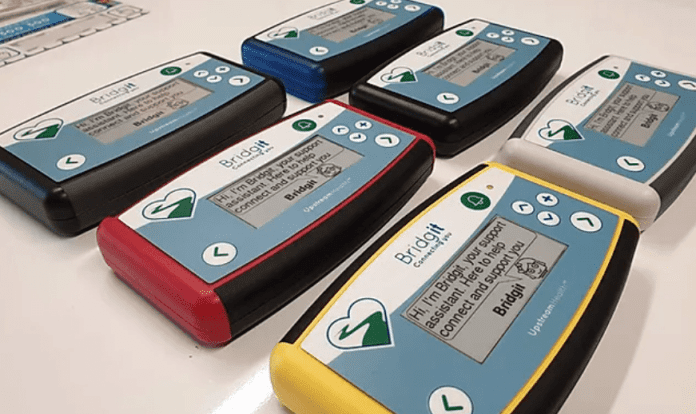Health tech startup Upstream Health has developed a low-cost IoT monitoring solution with the UK-based Thingstream division of IoT semiconductor maker U-Blox (branded ‘u-blox’) to help with remote care of elderly patients in their homes. The new solution could save the healthcare sector, with 250 million in home care globally, over £10,000 per patient over five years, the duo reckon.
UK-based Upstream Health recruited U-Blox Thingstream, acquired and integrated into Swiss firm U-Blox in April this year, to provide out-of-the-box connectivity for its battery operated Bridgit Home solution. U-Blox Thingstream offers low power wide-area (LPWA) IoT connectivity based on the sensor network (SN) variant of the MQTT lightweight messaging protocol (MQTT-SN).
Upstream Health, formed in 2017, is looking to deliver preventative care solutions using data to identify actions to “keep people well”. Its new Bridgit Home device (pictured) attaches to a patient’s fridge, and utilises nine sensors to take around 40 data measurements, including temperature, movement, fridge access, heart rate, oxygen saturation, and satellite positioning, among others.
Bi-directional data flow means information is shared with the clients’ families via an app, and carers can be alerted if abnormal activity is detected. Push notifications can be sent by family carers to check on the patient’s well-being; data analytics identifies ‘care intelligence’ patterns about normal and abnormal behaviour so predictive care interventions can be made.
Upstream Health said Wi-Fi connectivity required in-home tech-savvy, which its not guaranteed among ederly patients. It also noted “too many variables of error… for a quick, simple deployment”. It stated: “In some regions over 50 percent of our elderly community don’t even have an internet connection, and most of the community want to be supported not watched.”
The company looked at LoRaWAN, as well, and piggybacking on the “various LoRaWAN initiatives” being rolled out in UK cities. But it said upload and download transmission intervals were unsuitable, and “patchy coverage” would limit its ability to deploy the solution at scale. Instead, it settled on MQTT-SN as a GSM based solution.
U-Blox Thingstream’s MQTT-SN service, available with a management platform as-a-service bundle, offers data transfers by transmitting MQTT‑SN messages over 2G, 3G, LTE, and LTE‑M networks, making it a global service. It works with 600-odd telecom carriers in 190 countries without necessitating a cellular data plan.
It presents its MQTT-SN offer as an infrastructure-free alternative to the likes of Sigfox, LoRaWAN, and indeed NB-IoT, primarily for asset tracking and condition monitoring in logistics and supply chain sectors.
Darren Crombie, founder and chief executive at Upstream Health, commented: “How do you connect the unconnected? Without U-Blox Thingstream this solution would not be possible, it’s really that simple. At the core of the solution is the connectivity layer. Without reliable, cost effective, easy to install and secure connectivity the solution won’t work.”
The device will take “preventive care to the masses”, the company reckons, by helping patients who are often offline and disconnected. Two million elderly people currently receive social care in their home in the UK, and 250 million globally, the companies said. The coronavirus pandemic has put strain on social care services, alongside healthcare in general.
“The premise is that if data can be collected in an unobtrusive way from the elderly user and their home, then it could be used to better predict needs and provide preventative care,” said U-Blox Thingstream in a press statement. “The market is huge. The longer people can remain healthier and happier in their own home the less strain there is on hospital infrastructure. If you can streamline care in the community through big data the benefits are enormous.”
The UK’s NHS and PSS (Prescribed Patient Services) analysis of the solution suggests “wide deployment” of the solution could result in a net cost saving per patient of £10,382 over a five year period, said Upstream Health.

